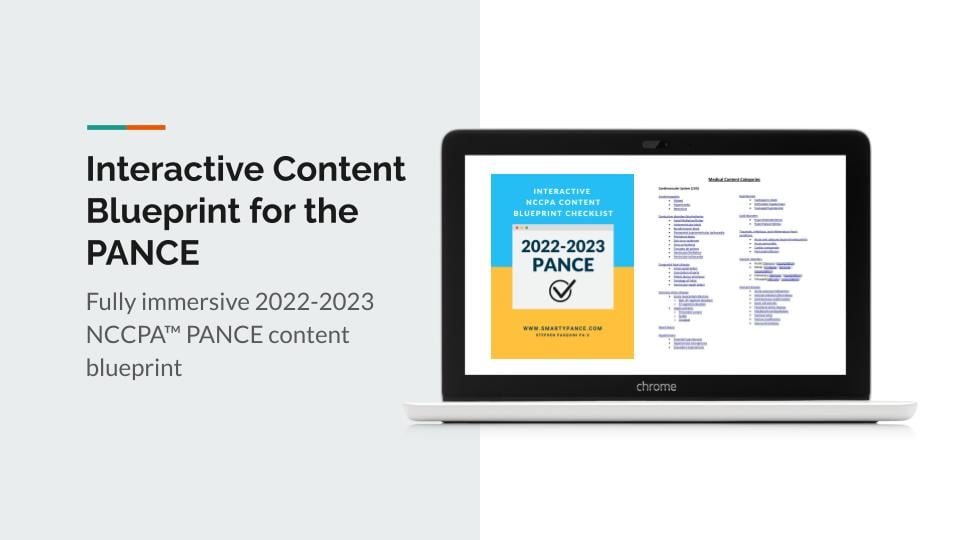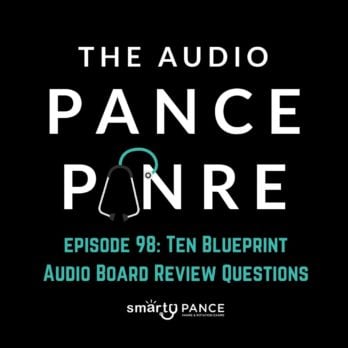Podcast: Play in new window | Download
Subscribe: Apple Podcasts | RSS
Welcome to episode 98 of the Audio PANCE and PANRE Physician Assistant/Associate Board Review Podcast.
Join me as I cover ten PANCE, PANRE, and EOR™ review questions from the Smarty PANCE Instagram/Facebook page and the smartypance.com board review website.
Special from today’s episode:
- Join the Smarty PANCE Member’s Community
- Check out our all-new End of Curriculum™ (EOC) Exam Course (still in development)
- Follow Smarty PANCE and The Daily PANCE Blueprint on Instagram
- Follow Smarty PANCE and The Daily PANCE Blueprint on Facebook
Below you will find an interactive exam to complement today’s podcast.
The Audio PANCE/PANRE and EOR PA Board Review Podcast
I hope you enjoy this free audio component to the examination portion of this site. The full board review course includes over 2,000 interactive board review questions and is available to all members of Smarty PANCE.
- You can download and listen to past FREE episodes here, on iTunes, Spotify, Google Podcasts, Stitcher, and most podcasting apps.
- You can listen to the latest episode, take an interactive quiz, and download more resources below.
Listen Carefully Then Take the Practice Exam
If you can’t see the audio player, click here to listen to the full episode.
Podcast Episode 98: Ten PANCE/PANRE and EOR Topic Blueprint Questions
1. An 81-year-old female presents to the ER with acute onset of low back pain. She complains of bowel dysfunction and loss of sensation over her inner thighs. Physical exam reveals decreased lower extremity reflexes. Which of the following is the best diagnostic test for the likely diagnosis?
A. Lumbar radiographs
B. MRI of the lumbosacral spine
C. CSF fluid analysis
D. Scoliosis studies
E. None of the above
2. Which of the following is the most common cause of Cushing syndrome?
A. Iatrogenic
B. Bronchogenic carcinoma
C. Pituitary adenoma
D. Adrenal adenoma
E. Obesity
3. A 73-year-old female presents with facial flushing, wheezing, and watery diarrhea for a few months. Her symptoms are worsened by certain foods. Which of the following is the best initial diagnostic study to order for the suspected diagnosis?
A. 5-HIAA in urine
B. Serum ACE levels
C. Chest radiograph
D. Upper endoscopy
E. Bronchoscopy
4. Which of the following is the most common cause of Mallory-Weiss Syndrome?
A. Iatrogenic
B. Vomiting
C. Abdominal trauma
D. Hiatal hernia
E. Corrosive ingestion
5. A 51-year-old male presents to the clinic complaining of “band-like pressure” around his head. He has been more stressed lately. Which of the following is the most likely diagnosis?
A. Cluster headache
B. Migraine with aura
C. Sinus headache
D. Tension headache
E. Medication overuse headache
6. Which of the following physical exam findings would you expect in a patient with mitral regurgitation?
A. Holosystolic blowing murmur best heard at the apex with radiation to the axilla
B. Diastolic blowing murmur at the left upper sternal border
C. Systolic ejection crescendo-decrescendo murmur at upper right sternal border
D. Mid-systolic harsh murmur best heard at the left upper sternal border
E. None of the above
7. Which of the following is not an expected clinical manifestation of polyarteritis nodosa?
A. Kidney failure
B. Livedo reticularis
C. pANCA positive
D. Pulmonary fibrosis
E. Hypertension
8. An 8-year-old female presents to the clinic with her dad. She is complaining of left ear pain and pruritus for the past few days. The physical exam is remarkable for drainage and pain on tragal pressure. The tympanic membrane can’t be visualized. Which of the following is the best treatment option?
A. Oral amoxicillin
B. Neomycin/polymyxin B/hydrocortisone drops
C. Oral cefepime
D. Oral steroids
E. Ciprofloxacin/dexamethasone drops
9. Which of the following correctly depicts the typical clinical features of Parkinson’s disease?
A. Pill-rolling tremor, bradykinesia, rigidity, masked facies
B. Loss of declarative episodic memory, apraxia, olfactory dysfunction
C. Visual hallucinations, REM sleep behavior disorder, gait issues
D. Hyperorality, apathy, socially inappropriate behavior
E. None of the above
10. A 72-year-old male presents with an abnormal change in bowel habits and fatigue. The physical exam is remarkable for pale conjunctiva and a palpable abdominal mass. His hemoglobin is 10 mg/dL. Which of the following is likely to be elevated?
A. Alpha-fetoprotein
B. CEA
C. CA-125
D. CA 19-9
E. AAT1
Looking for all the podcast episodes?
This FREE podcast series is limited to every other episode, you can download and enjoy the complete audio series by becoming a Smarty PANCE member.
I will be releasing new episodes every few weeks. Smarty PANCE is now discounted, so sign up now before it’s too late!
Additional resources and links from the show
- Download your Free interactive PANCE, PANRE, and EOR™ Blueprint Templates
- Follow Smarty PANCE and The Daily PANCE Blueprint on Instagram
- Follow Smarty PANCE and The Daily PANCE Blueprint on Facebook
- My list of recommended PANCE and PANRE review books
- Sign up for the FREE Daily PANCE and PANRE email series
- Join the Smarty PANCE NCCPA Content Blueprint Website
- Get your free 8-week PANRE Blueprint study schedule and the 8-week PANCE study schedule
- Get your free Trello PANCE study planner
- Get 20% of any Picmonic membership by using this link
This Podcast is available on iOS and Android
- You can download and listen to past FREE episodes here, on iTunes, Spotify, Google Podcasts, Stitcher, and most podcasting apps.
Download the Interactive Content Blueprint Checklist

Follow this link to download your FREE copy of the PANCE/PANRE/EOR™ Content Blueprint Checklists
Print it up and start crossing out the topics you understand, marking the ones you don’t, and making notes of key terms you should remember. The PDF version is interactive and linked directly to the individual lessons on Smarty PANCE.
Smarty PANCE is not sponsored or endorsed by, or affiliated with, the NCCPA or the Physician Assistant Education Association (PAEA). All trademarks are the property of their respective owners.

